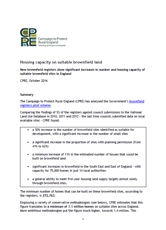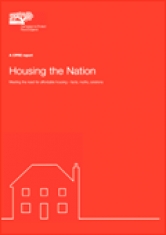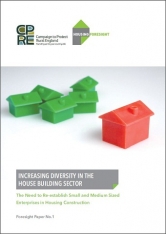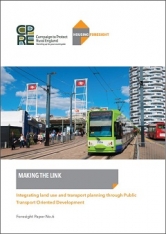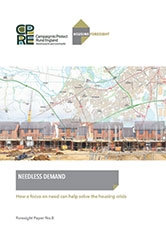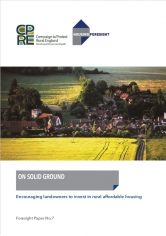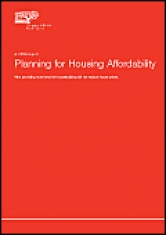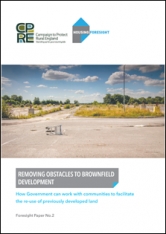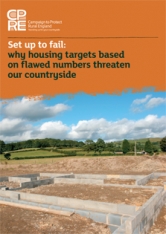Housing
Housing capacity on suitable brownfield land
The Campaign to Protect Rural England (CPRE) has analysed the Government’s brownfield registers pilot scheme. Employing a variety of conservative methodologies, CPRE now estimates that the available data translates to a minimum of 1.1 million homes on suitable brownfield sites across England. More ambitious methodologies put the figure much higher, towards 1.4 million. This suggests that the Government has previously severely underestimated brownfield capacity.
Housing the Nation
Meeting the need for affordable housing ? facts, myths, solutions
It is clear that there needs to be a significant increase in the provision of affordable housing – in both urban and rural areas. This briefing suggests what might be done to achieve this objective while ensuring that the countryside is protected from unnecessary development and the best use is made of existing urban land and buildings. It defines the extent and nature of affordable housing needs, challenges some of the myths surrounding the issue, and proposes measures that might be adopted nationally and locally to tackle it.
Increasing Diversity in the House Building Sector
The need to re-establish small and medium sized enterprises in housing construction
The first paper in CPRE's Housing Foresight series explores how the dominance of volume house builders is having potentially harmful impacts on the supply, location and design of new housing in England. It shows that greater support for small and medium sized house builders can help meet demand for housing and protect green spaces by delivering new homes - including through custom/self build - on smaller brownfield sites. The paper proposes four policy options: promoting small-scale brownfield sites; funding smaller builders; simplifying small applications; and the use of design codes.
Making the Link
Integrating land use and transport planning through Public Transport Oriented Development
The sixth paper in CPRE Housing Foresight series explores how effective coordination between transport and development can improve access to public transport, reduce pollution and encourage walking and cycling. The paper proposes ideas for identifying suitable sites, incentivising development and engaging local communities in the process.
Needless Demand: How a focus on need can help solve the housing crisis
Needless demand: How a focus on need can help solve the housing crisis is the eighth paper in CPRE's Housing Foresight series. It analyses the current method that councils use to plan for local housing and what is being built as a result. It finds that ‘housing need’ and ‘housing demand’ are being conflated in planning policy, with the result that numbers matter more than type and tenure of housing.
Needless Demand shows how Government could split need and demand, and so tackle the housing crisis more effectively. It calls for clearer definitions of ‘need’ and ‘demand’ to be applied to planning policy, and for councils to apply them to their housing targets and local plans.
New Homes Bonus: Sharpening the incentive
Response by the Campaign to Protect Rural England (CPRE) to the Government's technical consultation
On Solid Ground
Encouraging landowners to invest in rural affordable housing
The seventh paper in CPRE's Housing Foresight series looks at the crucial role landowners can play in helping to fix the rural affordable housing crisis. The paper explores how landowners can invest in affordable housing to benefit their communities, and looks at ways in which the Government can make it easier for them do so.
Planning for Housing Affordability
Why providing more land for housebuilding will not reduce house prices
We commissioned independent consultants Green Balance to conduct research into the relationship between planning, housing land supply and housing affordability. Our research found that increasing the supply of land for housing would make little difference to housebuilding rates or house prices. The report makes some recommendations which need to be reflected in future Government policy on housing needs.
Removing obstacles to brownfield development
With recent statistics showing that housing development is decreasing on previously developed sites but increasing on the Green Belt, Removing obstacles to brownfield development calls for Government to implement a range of inventive policies to realise the potential of brownfield house building.
The paper calls for:
- the taxation of uncompleted housing for which planning permission has been granted on brownfield land;
- improved funding and assistance for brownfield remediation;
- special planning measures and state intervention to aid redevelopment;
- and the increased use of tax increment financing.
Set up to fail: why housing targets based on flawed numbers threaten our countryside
Our new research has found that housing assessments produced by local authorities (SHMAs) are inaccurate, inflated and unreliable. The housing figures produced by SHMAs are not being balanced with sensible planning for infrastructure, consideration of environmental constraints, and realistic assessments of what housebuilders will be able to deliver.
The full report is also available: Smarter SHMAs: A Review of Objectively Assessed Need in England
